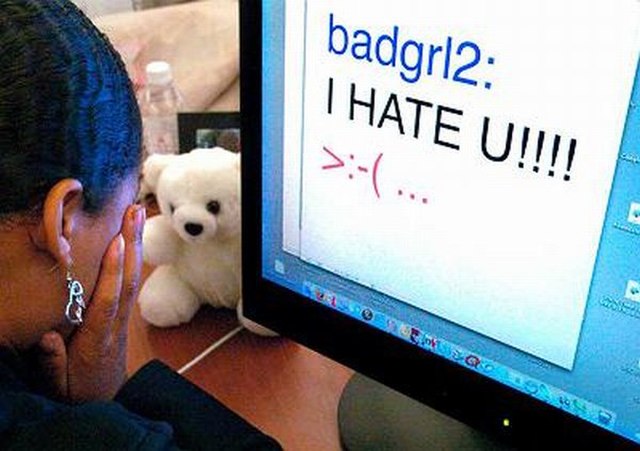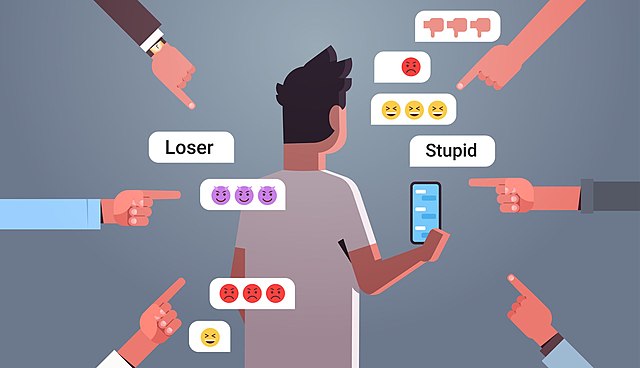
Introduction
In today’s digitally saturated landscape, the emergence of cyberbullying represents a contemporary form of harassment. Its insidious nature inflicts significant emotional and psychological harm on individuals spanning all age groups, including children, teenagers, and adults. Within the confines of this blog article, we embark on an exploration of cyberbullying, delving into its definition, its profound impact on individuals, and proactive measures to combat this stealthy menace.
What Is Cyberbullying?
Cyberbullying is the act of subjecting someone to harassment, threats, or intimidation through the utilization of digital communication platforms such as social networking sites, text messaging, email, or other online forms of interaction. It can appear in a variety of ways, including:
- Harassment: Sending threatening or abusive messages constantly.
- Flaming: Arguing online, frequently to offend or provoke.
- Outing: Sharing someone else’s personal information without getting permission.
- Impersonation: Damaging their reputation online by posing as someone else.
5. Exclusion: Barring someone on purpose from online groups or activities.

Cyberbullying and traditional bullying
Bullying, encompassing both traditional and cyberbullying, exhibits distinct approaches, audiences, and characteristics, albeit sharing a common aim of inflicting harm. Traditional bullying pertains to acts of aggression, threats, or harassment that transpire in real-world settings, characterized by direct interactions between the perpetrator and the target. Unlike cyberbullying, which unfolds in the digital realm, traditional bullying unfolds in physical locations such as schools, communities, businesses, or other tangible spaces. Moreover, traditional bullying often features a discernible power imbalance, with the aggressor leveraging physical strength, notoriety, or social influence to establish dominance over the victim, as elucidated by Rooney et al. (2012).
Traditional bullying and online bullying share a commonality characterized by three key attributes. As substantiated by numerous studies (Hunter, Boyle, & Warden, 2007; Kowalski, Limber, & Agatston, 2012; Olweus, 1993, 2013; P. K. Smith, del Barrio, & Tokunaga, 2012), both forms of bullying involve aggressive behaviour, often unfolding within relationships marked by an imbalanced power dynamic among individuals.
Despite sharing the common aim of causing harm, traditional bullying and cyberbullying diverge significantly in their methods, target audiences, and distinctive features. In sharp contrast to the physical form of conventional bullying, the distinctive features of the internet give users a veil of anonymity. As a result of the anonymity afforded by the internet, cyberbullying perpetrators are frequently more numerous. As they struggle with the feeling of helplessness that comes from not knowing their attackers, victims of this anonymity frequently feel helpless and hopeless. In addition, the lack of fast reaction in cyberbullying situations frequently results in the perpetrators lacking empathy and regret. Cyberbullies are protected from the emotional repercussions of their behaviour because the anonymity of the internet allows them to disregard the sentiments of those they target, unlike traditional bullies who may see firsthand the effects of their acts on their victims. The cycle of cyberbullying is frequently perpetuated by this lack of responsibility, as the absence of response encourages an environment in which ongoing abuse can continue unchecked.
Additionally, there is a significant difference in the time dynamics of cyberbullying compared to traditional bullying. Bullying that takes place in person often happens as people go about their normal lives. However, cyberbullying knows no temporal bounds, for it operates beyond the constraints of physical proximity. The vast expanse of the internet affords a unique characteristic: the capacity to store digital actions and words indefinitely. Consequently, the longevity of cyberbullying is perpetuated, rendering it an enduring and inescapable ordeal. Notably, cyberbullying often takes on a viral nature, as exchanges between the aggressor and the victim may disseminate widely, albeit within the confines of a particular online community. This stands in stark contrast to traditional bullying, which often remains confined to a limited audience. Cyberbullying can transpire within bustling chat rooms teeming with hundreds of users or on social media platforms frequented by millions. Moreover, victims of cyberbullying may not promptly discern the extent of their distress. Frequently, it is only when the deleterious effects of online harassment begin to infiltrate their everyday lives that victims respond, signifying the widespread reach and impact of the bullying.

Solutions and preventive measures
- Bystander’s help
In cases of widespread cyberbullying, there are often numerous witnesses. Online observers may, however, feel less compelled to intervene due to the distance and reduced social responsibility associated with the bystander effect. Nonetheless, bystanders have the potential to play a constructive role in similar situations. Consequently, whether cyberbullying continues or ceases often hinges on the response of peers who witness the incident, as their actions can either diffuse or escalate the situation (Allison and Bussey, 2016).
Bystander involvement is crucial in addressing cyberbullying because, in many instances, authorities such as police, teachers, and parents are often absent or unable to provide immediate assistance when bullying occurs (Vossekuil et al., 2004).
Active bystander engagement encompasses both intervention by appealing to the bully to cease their actions and providing comfort or assistance to the victim. Conversely, passive bystanders who remain uninvolved may opt to disengage from the bullying incident by leaving. Given that bystanders frequently advocate for the targets of bullying, this involvement has been shown to lead to a decrease in bullying (Salmivalli et al., 2011). Therefore, bystanders represent a crucial focus for interventions aimed at mitigating cyberbullying.
- Education
In the effort to prevent cyberbullying, the family plays a pivotal role alongside external bystander involvement. Teenagers with deficient family management are at a higher risk of engaging in risky behaviours, including bullying and violence. This deficiency can manifest as reduced parental supervision or unclear communication expectations within the family dynamic. Notably, there exists a close association between bullying behaviour and the level of family management (Hemphill et al., 2014).
A nurturing family environment can have a constructive impact on a child’s character development by providing support, fostering open communication, and offering praise. Adolescents who benefit from effective family management are inclined to recognize bullying as morally wrong and express their willingness to take proactive measures to support and protect bullying victims. Strategies for positive family management encompass fostering positive communication and expressing appreciation for commendable actions (Mulvey et al., 2019).
Conclusion
In today’s digital era, cyberbullying looms as a significant and insidious problem, infiltrating every facet of our technology-driven lives. This form of harassment inflicts profound emotional and psychological wounds on individuals across all age groups. This blog post delves into the intricacies of cyberbullying, dissecting its defining characteristics, the dire consequences it yields, and the strategies aimed at curbing its malevolent presence. Cyberbullying adopts a multitude of guises, including ostracism, impersonation, trolling, outing, and outright harassment. It stands apart as a unique and formidable challenge, transpiring in the vast and often anonymous expanse of the internet, in stark contrast to traditional bullying. While the common objective of causing harm unites traditional and cyberbullying, their methodologies, environments, and consequences diverge significantly. Traditional bullying unfolds in physical spaces, fostering direct encounters between perpetrators and victims, whereas cyberbullying thrives online, cloaked in anonymity and reaching a broader audience. Recognizing the distinctiveness of cyberbullying, this issue demands comprehensive scrutiny. The role of bystanders, both in the digital realm and offline, emerges as pivotal in combatting this menace. Their involvement can either quell or exacerbate situations, rendering their participation indispensable. Furthermore, education and awareness campaigns assume paramount importance in the battle against cyberbullying, necessitating enlightenment about the profound emotional toll it exacts, the cultivation of empathy, and the instillation of a collective sense of responsibility to intervene when encountering cyberbullying. Families, as the bedrock of support and values, wield significant influence in this fight. Effective family management fosters an environment discouraging cyberbullying through encouragement, transparent communication, and the reinforcement of positive behaviour. Adolescents, nurtured in such loving and empathetic family settings, are better equipped to reject bullying and actively extend their support to victims.
In conclusion, combating cyberbullying necessitates a multidimensional strategy that enlists the cooperation of individuals, families, schools, and communities. We can build a safer online environment where cyberbullying is not allowed by increasing knowledge, creating empathy, and encouraging active bystander participation. Together, we can defeat this online danger and promote a climate of decency, respect, and kindness.
Allison, K. R., & Bussey, K. (2016). Cyber-bystanding in context: A review of the literature on witnesses’ responses to cyberbullying. Children and Youth Services Review, 65, 183–194. https://doi.org/10.1016/j.childyouth.2016.03.026
Hemphill, S. A., Tollit, M., & Herrenkohl, T. I. (2013). Protective factors against the impact of school bullying perpetration and victimization on young adult externalizing and internalizing problems. Journal of School Violence, 13(1), 125–145. https://doi.org/10.1080/15388220.2013.844072
Hunter, S. C., Boyle, J. M., & Warden, D. (2007). Perceptions and correlates of peer-victimization and bullying. British Journal of Educational Psychology, 77(4), 797–810. https://doi.org/10.1348/000709906×171046
Mulvey, K. L., Gönültaş, S., Goff, E., Irdam, G., Carlson, R., DiStefano, C., & Irvin, M. J. (2018). School and family factors predicting adolescent cognition regarding bystander intervention in response to bullying and victim retaliation. Journal of Youth and Adolescence, 48(3), 581–596. https://doi.org/10.1007/s10964-018-0941-3
Rooney, A., & Learning, B. D. (2012). Bullying. Britannica Digital Learning. (Rooney et al., 2012)
Vossekuil, B. (2004). The final report and findings of the Safe School Initiative: Implications for the Prevention of school attacks in the United States. United States Secret Service.
Salmivalli, C., Voeten, M., & Poskiparta, E. (2011). Bystanders matter: Associations between reinforcing, defending, and the frequency of bullying behavior in classrooms. Journal of Clinical Child & Adolescent Psychology, 40(5), 668–676. https://doi.org/10.1080/15374416.2011.597090

